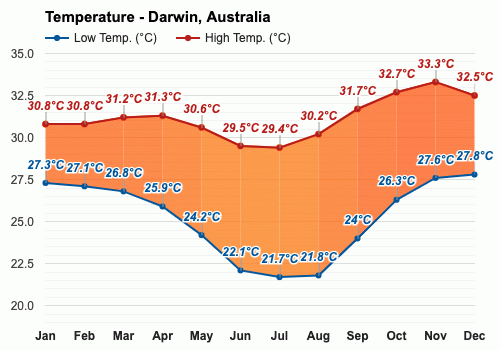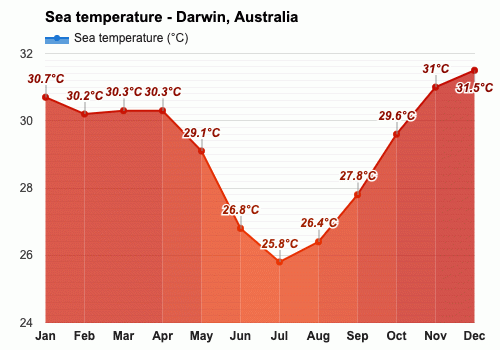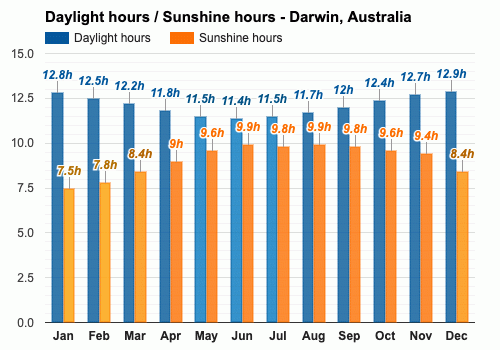Contents
- Weather in January
- Frequently asked questions
- Average temperature in January
- Average pressure in January
- Average wind speed in January
- Average humidity in January
- Average rainfall in January
- Average rainfall days in January
- Average sea temperature in January
- Average daylight in January
- Average sunshine in January
- Average sunshine days in January
- Average UV index in January
- Average cloud cover in January
- Average visibility in January
January
Weather in January
Temperature
As December transitions into January, Darwin records an average high-temperature of a still hot 30.8°C (87.4°F), showing a gentle shift from the preceding month. A minimal decline in temperature from daytime highs is anticipated in Darwin throughout the January nights, averaging a moderately hot 27.3°C (81.1°F).Heat index
The heat index value for January is appraised at a scorching 40°C (104°F). Adopt additional preventive measures, heat cramps and heat exhaustion are potential outcomes. Prolonged activity may trigger heatstroke.Evaluating the heat index requires understanding its values in the shade and with gentle winds. An exposure to direct sunlight may lift the heat index values by 15 Fahrenheit (8 Celsius) degrees.
Note: The heat index, also known as 'apparent temperature' or 'real feel', marries air temperature and humidity to produce a value illustrating perceived warmth. The influence of weather can be personal, changing with an individual's body mass, height, and level of physical exertion. Sunshine, when direct, has the potential to intensify weather effects, leading to an increase in the heat index by 15 Fahrenheit (8 Celsius) degrees. Heat index values are highly important for children. Young ones generally face higher dangers than adults since they sweat less. Along with their large skin surface area compared totheir small bodies and increased heat production from their activities, the risks are heightened.
To prevent overheating and help regulate its internal temperature, the human body sweat and rely on the evaporation to cool down. When relative humidity is on the rise, it curtails evaporation, thereby reducing the heat elimination from the body and causing the feeling of being excessively hot. When the body is unable to balance heat gain, its temperature elevates, which may induce thermal illnesses.
Humidity
The months with the highest humidity in Darwin are January and February, with an average relative humidity of 78%.Rainfall
The month with the most rainfall in Darwin is January, when the rain falls for 28.3 days and typically aggregates up to 340mm (13.39") of precipitation.Sea temperature
In January, the average sea temperature in Darwin is 30.7°C (87.3°F).Note: Water activities might not feel as soothing when temperatures are more than 30°C (86°F).
Daylight
In Darwin, the average length of the day in January is 12h and 46min.On the first day of the month, sunrise is at 6:24 am and sunset at 7:15 pm. On the last day of January, in Darwin, sunrise is at 6:40 am and sunset at 7:19 pm ACST.
Sunshine
With an average of 7.5h of sunshine, January has the least sunshine of the year in Darwin.UV index
The months with the lowest UV index are January through October and December, with an average maximum UV index of 7. A UV Index estimate of 6 to 7 represents a high health hazard from exposure to the Sun's UV radiation for the ordinary person.Note: A maximum UV index of 7 in January translates into the following recommendations:
Refrain from overexposure. Fair-skinned individuals could burn in under 20 minutes. Seek shade and limit direct Sun exposure between 10 a.m. and 4 p.m., when UV radiation is at its peak, but be aware that not all shade structures provide complete sun protection. Arm yourself against UV rays' harm with protective apparel and UV-filtering shades. Be on guard! The reflective nature of sand and water boosts UV exposure.
Published by: Weather Atlas | About Us
Data Sources | Weather Forecasting & Climate
Frequently asked questions
How hot is it in Darwin in January?
What is the most humid month in Darwin?
What is the average humidity in January in Darwin?
What is the wettest month in Darwin?
How many days does it rain in January in Darwin?
What is the sea water temperature in January in Darwin?
How many hours of daylight does Darwin have in January?
What time are sunrise and sunset in January in Darwin?
What is the month with the least sunshine in Darwin?
How many hours of sunshine does Darwin have in January?
When is the lowest UV index in Darwin?
What is the UV index intensity in January in Darwin?

Average temperature in January
Darwin, Australia
- Average high temperature in January: 30.8°C
The warmest month (with the highest average high temperature) is November (33.3°C).
The month with the lowest average high temperature is July (29.4°C).
- Average low temperature in January: 27.3°C
The month with the highest average low temperature is December (27.8°C).
The coldest month (with the lowest average low temperature) is July (21.7°C).

Average pressure in January
Darwin, Australia
- Average pressure in January: 1006.3mbar
The months with the highest atmospheric pressure are July and August (1013.2mbar).
The month with the lowest atmospheric pressure is January (1006.3mbar).

Average wind speed in January
Darwin, Australia
- Average wind speed in January: 15.3km/h
The windiest month (with the highest average wind speed) is January (15.3km/h).
The calmest month (with the lowest average wind speed) is September (9.9km/h).

Average humidity in January
Darwin, Australia
- Average humidity in January: 78%
The months with the highest relative humidity are January and February (78%).
The month with the lowest relative humidity is June (57%).

Average rainfall in January
Darwin, Australia
- Average rainfall in January: 340mm
The wettest month (with the highest rainfall) is January (340mm).
The driest months (with the least rainfall) are June, July and August (2mm).

Average rainfall days in January
Darwin, Australia
- Average rainfall days in January: 28.3 days
The month with the highest number of rainy days is January (28.3 days).
The month with the least rainy days is June (1.9 days).

Average sea temperature in January
Darwin, Australia
- Average sea temperature in January: 30.7°C
The best month for swimming (with the highest average sea temperature) is December (31.5°C).
The coldest month (with the lowest average sea temperature) is July (25.8°C).

Average daylight in January /
Average sunshine in January
Darwin, Australia
- Average daylight in January: 12h and 5min
The month with the longest days is December (Average daylight: 12h and 48min).
The month with the shortest days is June (Average daylight: 11h and 24min).
- Average sunshine in January: 7h and 3min
The months with the most sunshine are June and August (Average sunshine: 9h and 54min).
The month with the least sunshine is January (Average sunshine: 7h and 30min).

Average sunshine days in January
Darwin, Australia
- Average sunshine days in January: 1.4 days
The month with the most sunshine days is July (28.4 days).
The month with the least sunshine days is February (0.9 days).

Average UV index in January
Darwin, Australia
- Average UV index in January: 7
The month with the highest UV index is November (UV index 8).
The months with the lowest UV index are January, February, March, April, May, June, July, August, September, October and December (UV index 7).

Average cloud cover in January
Darwin, Australia
- Average cloud cover in January: 47
The month with the most cloud cover is January (Cloud cover 47).
The month with the least cloud cover is August (Cloud cover 9).

Average visibility in January
Darwin, Australia
- Average visibility in January: 9km
The months with the highest visibility are April, May, June, July, August, September, October and November (10km).
The months with the lowest visibility are January, February, March and December (9km).


